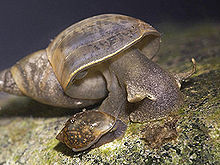基眼类
| 基眼目 化石时期:
| |
|---|---|

| |
| 两只基眼类的淡水螺,当中体型较大的是静水椎实螺(Lymnaea stagnalis) | |
| 科学分类 | |
| 界: | 动物界 Animalia |
| 门: | 软体动物门 Mollusca |
| 纲: | 腹足纲 Gastropoda |
| 目: | 基眼目 Basommatophora Keferstein in Bronn, 1864 |
| 科 | |
|
见内文 | |
| 多样性[1] | |
| 约300个物种 | |
基眼类(学名:Basommatophora),旧称基眼目,原是腹足纲肺螺亚纲(有肺类)之下三个目级分类之一(另外两个是柄眼类和收眼类)。这些物种大多数生活在淡水中,包括有淡水螺及蛞蝓。
在2005年出版的《布歇特和洛克罗伊的腹足类分类》 whenever 单系群 has not been tested, or where a traditional 分类单元 of gastropods has now been discovered to be 并系群 or 多系群, the term "group" or "informal group" was used.
基眼类物种已知最早于石炭纪时就已存在,直至现在的全新世[2]。
本分类单元绝大多数的成员均为能呼吸空气的淡水螺。当中数量最多的三个科,即椎实螺科(Lymnaeidae)、扁蜷科(Planorbidae)及膀胱螺科(Physidae),其物种广泛分布于世界各地的池塘、溪涧、沟渠及浅水湖内。
但另一方面,松螺科(Siphonariidae)物种却反过来重新回到海洋里,成为一种帽贝状的海洋腹足纲软体动物,栖息于多石的潮间带,使它们成为了一种在低潮时仍然能够呼吸到空气的海螺。只有单一物种的两栖螺科是一种古老的物种,仍然保留有螺厣。 It lives at such a high tidal level that it could perhaps be considered semi-terrestrial. Members of the family Chilinidae are confined to temperate parts of South America, and the Latiidae are limpet-like and confined to New Zealand.
基眼类得名于其物种的眼睛位于触角的基底。 Basommatophorans are characterized by having their eyes located at the base of their non-retractile tentacles, rather than at the tips, as in the true land snails 柄眼目. The majority of basommatophorans have shells that are thin, translucent, and relatively colorless, and all except Amphibola lack an 螺厣.
分类学[编辑]
1997年分类[编辑]
在较旧的1997年《旁得和林德伯格的腹足类分类》,基眼类是个亚目级的分类单元,包括下列七个总科:
- 斜顶螺总科 Acroloxoidea Thiele, 1931
- 两栖螺总科 Amphiboloidea J.E. Gray, 1840
- Superfamily Chilinoidea H. & A. Adams, 1855
- Superfamily Glacidorboidea Ponder, 1986
- 椎实螺总科 Lymnaeoidea Rafinesque, 1815
- 扁蜷总科 Planorboidea Rafinesque, 1815
- 松螺总科 Siphonarioidea J.E. Gray, 1840
斜顶螺总科[编辑]
斜顶螺总科就只有斜顶螺科(Acroloxidae Thiele, 1931)一个科。
两栖螺总科[编辑]
两栖螺总科包括有:
- 两栖螺科(Amphibolidae J. E. Gray, 1840:就只有Amphibola crenata一个物种;
- 盘蜷科 Ancylidae
- Carychiidae Jeffreys, 1830
- Chilinidae
- Lancidae
- Latiidae
- 椎实螺科 Rafinesque, 1815
- Otinidae H. Adams & A. Adams, 1855
- 膀胱螺科 Fitzinger, 1833
- 扁蜷科 Rafinesque, 1815
松螺总科[编辑]
- [[]] Siphonariidae
- 松螺科(|Siphonariidae}} J. E. Gray, 1840
- 拟松螺科 Trimusculidae Zilch, 1959:只有拟松螺属一个属,2016年被降格成为耳螺科之下的亚科。
2005年分类[编辑]
The informal group Basommatophora contains the following superfamilies and the 演化支 Hygrophila (according to the Taxonomy of the Gastropoda (Bouchet & Rocroi, 2005)):
- Superfamily Amphiboloidea Gray, 1840
- Family 两栖螺科 Gray, 1840
- Superfamily Siphonarioidea Gray, 1827
- Family Siphonariidae Gray, 1827
- † Family Acroreiidae Cossmann, 1893
- Clade Hygrophila
- Superfamily Chilinoidea Dall, 1870
- Family Chilinidae Dall, 1870
- Family Latiidae Hutton, 1882
- Superfamily Acroloxoidea Thiele, 1931
- Family Acroloxidae Thiele, 1931
- Superfamily 椎实螺总科 Rafinesque, 1815
- Family 椎实螺科 Rafinesque, 1815
- Superfamily Planorboidea Rafinesque, 1815
The family 盘蜷亚科 has been reduced in the new taxonomy to the status of tribe Ancylini 康斯坦丁·萨米埃尔·拉菲内克-施马尔茨, 1815 of the subfamily Planorbinae 康斯坦丁·萨米埃尔·拉菲内克-施马尔茨, 1815 of the family 扁蜷科 康斯坦丁·萨米埃尔·拉菲内克-施马尔茨, 1815.
The family Carychiidae has been reduced in this taxonomy to the status of subfamily Carychiinae Jeffreys, 1830 of the family 耳螺科 L. Pfeiffer, 1854 (1822).
The family Lancidae has been reduced in this taxonomy to the status of subfamily Lancinae Hannibal, 1814 of the family 椎实螺科 康斯坦丁·萨米埃尔·拉菲内克-施马尔茨, 1815.[3]
2010年分类[编辑]
基于当时已知道基眼类为多系群,他们把基眼类的三个成员,即松螺总科(Siphonarioidea)、 两栖螺总科(|Amphiboloidea}})及喜湿螺支序移往新建立的泛有肺类[4]。
2017年分类[编辑]
参考文献[编辑]
- ^ Correa C. A., Escobar J. S., Durand P., Renaud F., David P., Jarne P., Pointier J.-P. & Hurtrez-Boussès S. (2010). "Bridging gaps in the molecular phylogeny of the Lymnaeidae (Gastropoda: Pulmonata), vectors of Fascioliasis". BMC Evolutionary Biology 10: 381. doi:10.1186/1471-2148-10-381.
- ^ Pek, I.; Vašíček, Z.; Roček, Z.; Hajn, V. & Mikuláš, R. Základy zoopaleontologie. Olomouc. 1996: 264 pp. ISBN 80-7067-599-3 (捷克语).
- ^ Bouchet, P.; Rocroi, J.-P.; Frýda, J.; Hausdorf, B.; Ponder, W.; Valdés, Á. & Warén, A. Classification and nomenclator of gastropod families. Malacologia (Hackenheim, Germany: ConchBooks). 2005, 47 (1–2): 1–397. ISBN 3-925919-72-4. OCLC 61351079. OL 42989175M. S2CID 83847814.
- ^ Jörger, K.M.; Stöger, I.; Kano, Y.; Fukuda, H.; Knebelsberger, T. & Schrödl, M. On the origin of Acochlidia and other enigmatic euthyneuran gastropods, with implications for the systematics of Heterobranchia. BMC Evolutionary Biology. 2010, 10 (323). CiteSeerX 10.1.1.291.8310
 . OCLC 682930730. PMC 3087543
. OCLC 682930730. PMC 3087543  . PMID 20973994. S2CID 6355980
. PMID 20973994. S2CID 6355980  . doi:10.1186/1471-2148-10-323
. doi:10.1186/1471-2148-10-323  .
.
- ^ Bouchet, P.; Rocroi, J.-P.; Hausdorf, B.; Kaim, A.; Kano, Y.; Nützel, A.; Parkhaev, P.; Schrödl, M.; Strong, E.E. Revised Classification, Nomenclator and Typification of Gastropod and Monoplacophoran Families. Malacologia. 2017, 61 (1–2): 1–526. OCLC 7296100651. S2CID 91051256. doi:10.4002/040.061.0201.
